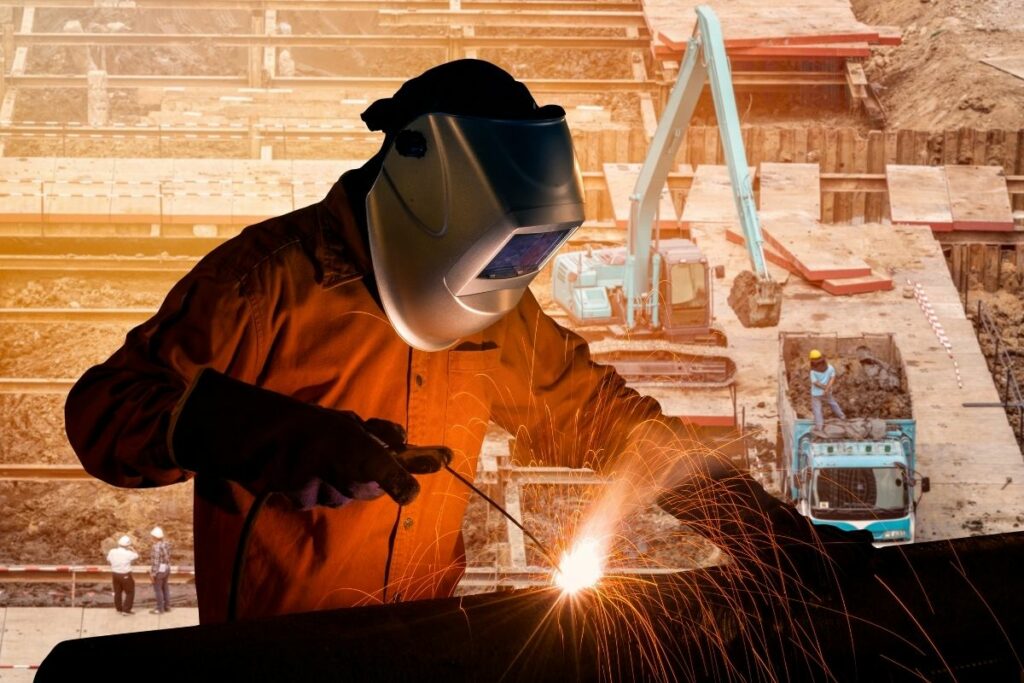
In many situations and often when you ask anyone about welding, you’ll get a response or an image that welding is merely a man wearing a face shield and a dirty coverall, holding a welding torch that gives out light during welding But in reality, there’s more to welding than this visual.
There’s a huge field that including but not limited to construction, automotive industries, shipbuilding, aircrafts industry, maintenance and repair work , turbine fabrications, boilers fabrication, and pipelines among many others.
Let us have a look in detail about the different fields in which welding is used.
Construction projects are a major part in employing the different welding professions. Construction projects include and not limited to bridge building, residential buildings, power stations, refinery stations, water treatment stations, pipelines construction in which- , most of work includes welding like rebar welding in civil work, piping work in refinery, power stations and water treatment stations in addition to the steel structure welding work included in this type of welding fields.
Manufacturing industries include fabricated metal products like metallic parts, pressure vessels, machinery, automotive, etc. Welding is used on a large scale in this field due to the mass production of produced metallic parts and components.
Steel structures participates in a lot of industries including construction companies, mining companies, aerospace companies, oil and gas companies and shipbuilding companies. Welding is used on a large scale due to the high tonnage of work produced.
In this area of welding work, sheet metal products are produced by cutting and forming the sheets of metal to the required shape and then welded and tested. These products are installed in construction sites by welding as most of these products are transferred to construction sites. They come – in the form of fabricated pieces which are connected together at sites like flare, stacks , static equipment like pressure vessels, drums, columns, etc.
Boilers are usually required in refineries and natural resources companies. Boilers are made of iron, copper, and stainless steel. Meaning, they require welding during fabrication, installation, and maintenance works during service.
Industries usually have a lot of machinery and equipment that are exposed to wear and tear during service which may lead to damage that requires maintenance by using welding. The maintenance works include and not limited to repair works, modifications and sometimes fabrication of new items.
Ship building is one of the heavy industries that contain welding as a main part of work. Shipyard usually contains other activities other than ship building including fabrication of military vessels, fabrication of research vessels in addition to fabrication, maintenance, and repair of all the equipment related to ships.
Underwater work includes repair and maintenance of underwater pipelines, ships, dams, offshore drilling rigs, sub-sea habitats and also in nuclear power facilities. Welding is carried out under tough conditions of high pressure of water and lower visibility in addition to the absence of a normal atmosphere- , so the welder shall hold oxygen vessels for breathing.
There are various welding jobs with different titles assuming different duties of work and responsibilities. Some of the common jobs with varying titles used in welding are:-.
This is a general title for the one who is able to weld two metals together by fusion and often used for manual arc welding. There are many manual arc welding processes but the most common ones are GTAW or TIG and SMAW, in which welders skills are different where each process needs a separate qualification.
This job describes the one who can weld two metals together by fusion using a semi-automatic or automatic welding process. The most common semi-automatic and automatic welding processes are flux cored arc welding (FCAW), gas metal arc welding (GMAW) and submerged arc welding (SAW).
This job describes the one who is able to join metals together by heating up metals with fusion where the fillers which are used have a melting point lower than that of joined base metals.
This job describes the one who is able to cut metals to pieces with the required dimension by applying heat to metals. The common cutting processes are oxy fuel cutting and plasma cutting.
This is the one who is responsible for inspecting the produced welds and assuring that the weld quality meets the requirements of applied welding standards and welding specifications.
In New Zealand, you can explore these job opportunities available in the labour market by holding a welding certificate and a trade ticket confirming that you are qualified to work in this job. The trade ticket is obtained by studying in any registered welding academy.
For more information about welding how to get started in your training journey, browse through our blog or website.